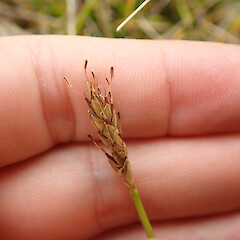Carex parvispica
Common name
Sinclair’s hook sedge, Sinclair’s bastard grass
Synonyms
Uncinia sinclairii Boott in Hook.f.
Family
Cyperaceae
Flora category
Vascular – Native
Endemic taxon
Yes
Endemic genus
No
Endemic family
No
Structural class
Sedges
NVS code
The National Vegetation Survey (NVS) Databank is a physical archive and electronic databank containing records of over 94,000 vegetation survey plots - including data from over 19,000 permanent plots. NVS maintains a standard set of species code abbreviations that correspond to standard scientific plant names from the Ngä Tipu o Aotearoa - New Zealand Plants database.
UNCSIN
Chromosome number
2n = 94, 96
Current conservation status
The conservation status of all known New Zealand vascular plant taxa at the rank of species and below were reassessed in 2017 using the New Zealand Threat Classification System (NZTCS) – more information about this can be found on the NZTCS website. This report includes a statistical summary and brief notes on changes since 2012 and replaces all previous NZTCS lists for vascular plants.
Please note, threat classifications are often suggested by authors when publications fall between NZTCS assessment periods – an interim threat classification status has not been assessed by the NZTCS panel.
- Conservation status of New Zealand indigenous vascular plants, 2017 . 2018. Peter J. de Lange, Jeremy R. Rolfe, John W. Barkla, Shannel P. Courtney, Paul D. Champion, Leon R. Perrie, Sarah M. Beadel, Kerry A. Ford, Ilse Breitwieser, Ines Schönberger, Rowan Hindmarsh-Walls, Peter B. Heenan and Kate Ladley. Department of Conservation. Source: NZTCS and licensed by DOC for reuse under the Creative Commons Attribution 4.0 International licence.
2017 | At Risk – Declining | Qualifiers: DP, Sp
Previous conservation statuses
2012 | Data Deficient | Qualifiers: Sp
2009 | Data Deficient | Qualifiers: Sp
2004 | Sparse
Distribution
Endemic. South Island in the east from near Tarndale, Marlborough south.
Habitat
Low montane to subalpine in wet or boggy ground within tussock grassland. In Otago it is often found at the base of tors, stream banks, or in seepages.
Wetland plant indicator status rating
Information derived from the revised national wetland plant list prepared to assist councils in delineating and monitoring wetlands (Clarkson et al., 2021 Manaaki Whenua – Landcare Research Contract Report LC3975 for Hawke’s Bay Regional Council). The national plant list categorises plants by the extent to which they are found in wetlands and not ‘drylands’. The indicator status ratings are OBL (obligate wetland), FACW (facultative wetland), FAC (facultative), FACU (facultative upland), and UPL (obligate upland). If you have suggestions for the Wetland Indicator Status Rating, please contact: [Enable JavaScript to view protected content]
FAC: Facultative
Commonly occurs as either a hydrophyte or non-hydrophyte (non-wetlands).
Detailed description
Blue-grey to dark green shortly rhizomatous, spreading, turf-forming sedge. Rhizomes 1–2 mm diameter. Culms 70–300 × 0.5–1 mm, erect, usually glabrous, though occasionally faintly scabrid just below inflorescence; basal bracts dull grey-brown. Leaves 6–9 per culm, blue-grey to dark green, < or rarely almost equal to culm in length, 1.5–4 mm wide, very stiff. Spikes 10–20 × 4–7 mm, oblong to obovate, ebracteate, male flowers obscured by 10–15 larger surrounding female flowers, close-set, internodes about equal. Glumes same length as utricles, persistent, ovate, obtuse or subacute, coriaceous, straw-coloured, rarely light greyish brown with abroad, pale green midrib, the central nerves thickened and conspicuous. Utricles 4.5–6 × 1.5–2 mm, plano-convex, elliptical, coriaceous, grey-brown, nerved below and with a prominent lateral nerve, hispid on margins and both surfaces of upper half, beak and stipe scarcely narrowed, 0.5 mm long.
Similar taxa
Very close to Carex subtilis K.A.Ford from which it differs by its much broader, rather stiff, blue-grey to dark green leaves, broader spikes and utricles. The utricles are more prominently nerved than those of C. subtilis, while the glumes are invariably straw-coloured rather than dark brown or brown-tinged.
Flowering
October–December
Fruiting
October–June
Propagation technique
Has been cultivated. It is easily grown but rather slow to establish. Fresh seed germinates easily and plants can be grown by division. Its exact requirements are not clear, though it dislikes humidity and will not flower in northern New Zealand without cold treatment.
Threats
Believed to be a naturally uncommon, ecologically sparse species. However it is poorly known from large parts of its reported range. Further survey to ascertain its exact status is much desired.
Etymology
carex: Latin name for a species of sedge, now applied to the whole group.
Where To Buy
Not commercially available
Attribution
Description adapted from Moore and Edgar (1970). Fact sheet prepared by Peter J. de Lange (17 August 2006).
References and further reading
Moore LB, Edgar E. 1970. Flora of New Zealand, Volume II. Indigenous Tracheophyta: Monocotyledones except Gramineae. Government Printer, Wellington, NZ. 354 p.
NZPCN Fact Sheet citation
Please cite as: de Lange, P.J. (Year at time of access): Carex parvispica Fact Sheet (content continuously updated). New Zealand Plant Conservation Network. https://www.nzpcn.org.nz/flora/species/carex-parvispica/ (Date website was queried)






